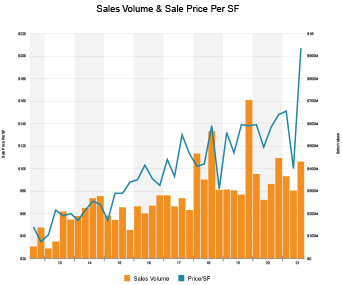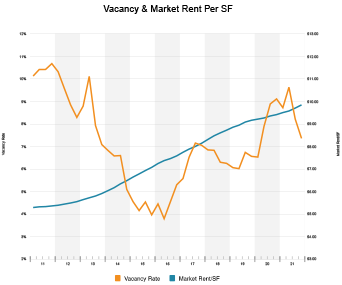State of the Market: Industrial Activity in Denver
Published Expert Article
by M. Chandler Lisle
Associate Advisor at Pinnacle Real Estate Advisors
The state of the market around the Denver Metro area over the last 12-18 months has been nothing short of noteworthy. From a booming market prior to the COVID-19 pandemic, to the slow in activity following the stay-at-home order issued by Governor Polis affecting individual owners and businesses last year, now to the v-shaped recovery curve that’s led us to the bustling state of the market we see today, it has been quite a ride for both industrial users and investors in the Denver Metro market.
Over the few years leading up to the Covid-19 pandemic, demand for industrial product rose to the second most attractive product type for investors in Denver, just behind multifamily investments, due to increasing population growth driving rental demand from small business owners for industrial use properties, as well as secular trends such as e-commerce growth driving demand for warehouse and distribution center capacity. Beyond end-users, the market also observed an increased amount of institutional capital flow into the Denver Metro area industrial market, which made supply for quality, large-scale assets increasingly scarce, pushing values up. Cap rates, which for the average credit tenant averaged around 7.5-8% in the years prior to the pandemic, are now averaging around 6-7% on market transactions observed over the current term. The journey to get to this current point of strength, however, is one worth discussing.
From March through June of last year, the Denver market experienced the greatest negative local economic impact seen since 2008. In March, the State-wide Stay at Home Order issued from Governor Polis created a unique disruption in the local market. Many businesses deemed “unessential” became unable to operate in-person, which made their businesses vulnerable. Fortunately, industrial owner-users historically represented the majority of industrial property ownership surrounding Denver, many of which were deemed essential businesses, which helped enable the industrial market fare better than other real estate product types.
With regards to financial conditions, the historically low interest rates entering the pandemic were pushed even lower and remain at highly attractive levels today. Lower borrowing costs played a role in supporting the industrial market when new deal activity slowed during the depths of the pandemic in 2020, and have since contributed to the rise in property values as buyers are able to pay higher amounts for a similar return. In some cases, the competition for deals has driven expected returns lower. On the other hand, owners have been able to benefit by selling at all-time-high prices, especially to other owner-users who have few alternatives to paying a premium for the right space for their business. In particular, industrial yard space is currently seeing record demand and price per square foot levels in the Denver Metro area, exacerbated by a dwindling amount of supply. In some cases, industrial property with fenced yard has doubled or even tripled in value due to zoning laws that only allow outdoor storage in specific areas around Denver. A recent example is 8000 E 96th Ave, a 4,000 square foot metal building sitting on 17 acres of I-3 Commerce City zoned land, which brought $1,750/SF, or $7,000,000 at the end of September 21’ to be repurposed into a Class A warehouse and distribution logistics center, while offering ample yard space for users.


From taking the pulse of hundreds of property owners and investors across the Denver Metro Industrial market this year, “cautiously optimistic” is the outlook for many as we look forward into the market in 2022. More industrial owners who have held properties with significant equity built up over time have caught wind of the increase in property values and many are coming to the conclusion that now is an ideal time to sell, which means there could an increased supply of industrial properties coming to market.
As we look out to 2022, we see many economic indicators trending positively, which should support a robust economy and in turn, robust demand for industrial properties. While the rise in property values over the last 18 months has been incredibly strong, we see prices being grounded by fundamentally-driven local demand surrounding Denver. However, the local growth and economic environment statewide remains exposed against several factors the market should keep a close eye on. Macroeconomic factors and economic policies stemming from the top-down, paired with the month over month rise of inflation compared to 2020, and various supply chain hurdles including rising material and labor costs will continue to impact industrial real estate moving forward in the Denver market. 2022 should present a robust period of market activity for both buyers and sellers, and we look forward to strapping into our brokerage seats and being a part of yet another historic ride.
Featured in CREJ’s December 2021 Office and Industrial Properties Quarterly
